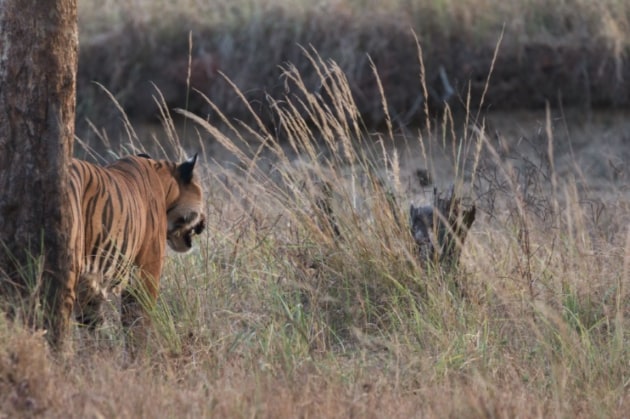Tiger’s Habitat

What is a tiger’s habitat?
Tigers can live in many habitats, depending on where in the world they live, and what kind of tiger they are.
Here we will explore all the different habitats that a tiger might live in, but before we do this, let’s have a quick look at the different types of tigers first, shall we?

Different kinds of tiger
Tigers are the largest members of the cat species, and their particular species name is Panthera Tigris. There are nine subspecies of tigers, however, three of them are extinct now. Tigers also make up one of the big four that can roar! With the other three being: lions, leopards and jaguars.
Did you know: Each tiger’s stripes are unique and individual, just like human fingerprints, no two are the same!
Here are the nine different types of tigers:
The Amur/ Siberian tiger. These tigers are the largest of the remaining subspecies, with males growing in excess of 10.5 feet (from head to tail), and weighing up to 660 pounds. Females are smaller, but can still grow to an impressive 8.5 feet (head to tail), and weigh up to 370 pounds.
Siberian tigers are characterised by their brown, as opposed to black, stipes. They have white bellies, as well a white ruff of fur around their necks. Their orange fur is paler than the other tiger sub-species too.
Siberian tigers can be found primarily in Eastern Russia, though some are also located in China and Noth Korea.
The Bengal/ Indian tiger. This category of tiger boast the largest number of subspecies. Though despite this, they are still listed as endangered specie on the IUCN Red List. They are probably the most well known and widely recognised out of all the tigers.
The Bengal tiger can be identified by their yellow to light orange coat, and their stripes range from dark brown to black. Their tales are orange with black rings. Some Indian tigers also posses a recessive gene, which can cause their fur to appear cream or white. These ‘white’ or ‘albino’ tigers are rarely found in the wild, but they can be found in captivity.
Bengal’s tigers live in India, and they are the national animal of India and Bangladesh.

The South China Tiger. The South China tiger is listed as Critically Endangered on the Red List, one level above Endangered. The WWF report these tigers are functionally extinct, as most of them only exist in captivity.
The exact number of the South China tigers in the wild, if any at all, is largely unknown. This is because 40 years ago, the Chinese Government declared them as pests. With only 4,000 of them remaining at the time, it is believed that they were hunted and killed.
South China tigers, compared to their subspecies, are smaller. They also have broader stipes, that are spaced further apart. They possess lots of distinct markings around their face.
The Malayan Tiger. The Malayan Tiger used to be categorised with the Indo-Chinese tiger until 2004. This is because they are very similar, except the Malayan tiger is smaller.
The Malayan tiger can be found in the tropical and subtropical forests in Southern Thailand and Peninsular Malaysia.
Malayan tigers also have orange-coloured fur and black stripes, with white fur on their eyes, cheeks and bellies. The black stipes are generally thinner than the other types of tiger,and help provide the perfect camouflage out in the jungle.
The Malayan Tiger is the national symbol of Malaysia, and they can be found on the coat of the Malaysian Army uniform.
These kinds of tigers tend to live very remotely in hilly and mountainous terrain, so very little is known about their numbers. They are also listed as endangered on the IUCN Red List.
The Sumatran Tiger. These tigers are protected by the law in Indonesia, and poachers face tough jail sentences if they defy these laws. Despite this, the tigers are still hunted, and their body parts and skin remain in high demand.
The Sumatran Tiger has the darkest coat out of all the tigers, They can be characterised by their broad black stripes, that are closely spaced and sometimes doubled. The Sumatran tiger also has striped forelegs, unlike the Siberian tiger.
These tigers can only be found on the Indonesian Island of Sumatra.
The Bali Tiger. Sadly, this tiger is now reported as extinct, with the last sighting of the Bali tiger recorded in Western Bali, in the late 1930s.
The cause of extinction was largely down to poaching, and their loss of safe habitat, resulting in a loss of prey too. There are no Bali Tigers in captivity either.
The Javan Tiger. These tigers, unfortunately, are also extinct. The last record of them is from Java’s Meru Betrir National Park in 1976.
Again, these tigers were hunted out of existence, and their habitat was converted for human use.
The Capsian Tiger. The last of our nine big cats, and also now extinct. The Capsian Tiger was declared extinct in the 1970s.
Before their extinction, Caspian tigers were one of the largest sub-specie of tiger, with a strong physique, wide paws, and unusually large claws. They fed on wild boar, and sometimes red deer, roe deer, and dogs too.
Just like the other extinct tigers, the Caspian Tiger was heavily hunted in the early twentieth century. They also suffered from a loss of natural habitat and loss of prey. Capsian Tigers were native to Turkey, Iran, Asia, Afghanistan and China.

What is a habitat?
A habitat is a place where any organism makes its home. For a habitat to be successful, it needs to meet a certain set of requirements, so that the organism can survive. In the instance of tigers, that means there must the correct weather conditions, enough food, in the form of prey, and plenty of mating opportunity.
As such, the main factors that indicate the suitability of a habitat are; shelter, food, water and space. A habitat is said to be appropriate when it has the right balance of all of these. Sometimes it might be the case that an area meets only some criteria, but not all. Or, a habitat may start off meeting all the requirements, but over time, become inhabitable. This can be due to natural causes, such as climate change, or due to human activity and /or interference.

Different kinds of habitat for a tiger:
As we can see, there are many types of tigers, living all around the world. This means they will live in all sorts of different conditions too, from sun to snow, it seems that tigers can weather it all.
Though we have briefly touched upon where each tiger can be found, we can now take a more in depth look at the question of, what is a tiger’s habitat?

Perhaps the most striking of habitats for a tiger is Russia’s Birch Forest. Home to the Siberian Tiger, these tigers’ habitat has a far harsher northern climate than those of the other tigers. Here you will find long, cold, and dark winters accompanied by mild summers, that bring tropical storms and typhoons. Winds coming in from Siberia bring in cooler, dry air, causing lots of snow. January can reach temperatures as low as -20 degrees, yikes!
The advantages of this habitat however, is that the forests see a much lower human population than other tigers’ habitat. As a result, the tigers are less likely to face threats from human interference and hunting. The vast woodlands allow the tigers lots of room to roam, and provide a healthy ecosystem.

However, it is Asia that hosts the most tigers, offering home to the Bengal. Bengal’s tigers can be found throughout the whole of India, and smaller tigers such as the Malayan and the Indo-Chinese tiger tend to live in southern, warmer countries such as Laos, Vietnam and Cambodia.
Tigers can live in a variety of environments. Here’s some more facts about tigers’ habitats:
- Evergreen Forests: Made up of evergreen trees, they exist in a range of climates and can contain acacia, banksia and eucalyptus trees in more temperate zones. Due to the fact that there is no seasonal loss of leaves, the trees provide excellent shade and cover for tigers to evade hunters and stalk their prey.
- Mangrove Swamps: Formed by mangrove trees in slightly salty tidal waters, mangrove swamps are found in coastal areas. They help to create a diverse ecosystem which is rich in wildlife. The Sundarbans Mangrove area between India and Bangladesh is the home of the Bengal tiger.
- Tropical Rainforests: Found near the Earth’s equator, the world’s largest tropical rainforests receive about 150 cm to 400 cm of rain per year. The combination of moisture and warmth make them the most biodiverse places on the planet. Rich in wildlife, tropical rainforests are an excellent habitat for the carnivorous tiger.
- Savannahs: Characterized by grasses and trees spread out, so they do not create a canopy, the savannah has rainfall in one season of the year. It provides a large area for the tiger to roam.
- Grasslands: Offering a continuous covering of grasses and fewer taller plants, like trees and shrubs, grassland areas are the most common in the world. They’re home to larger mammals which are the tigers’ prey.
- Mountains: With steep sides and exposed bedrock, mountains are elevated areas of the Earth’s crust. Amazingly, some tigers inhabit mountain regions. In 2010, a population of Bengal tigers were found at 13,000 feet in the Himalayas.
The vast array of habitat a tiger can thrive in demonstrates what an adaptable creature they are. Though tigers are not naturally found in Africa, Europe or America, or captivity, they have been known to survive remarkably well in these places.

What do tigers eat?
In order for tigers to get on in their habitat, there needs to be an abundance of food to keep them alive. It may come as no surprise to hear that all tigers are carnivores; they eat meat. Most tigers’ diet will be made up of large prey, like deer, rhino’s, elephant calves, or pigs.
To kill their prey, tigers will attempt to clamp down on the subject’s neck with their jaws, to suffocate the animal. The teeth of a tiger posses pressure sensing nerves, so they know exactly where to deliver the fatal blow. Though tigers are strong and fierce animals, they actually only achieve success in 10% of their hunts.
Threats to a tiger’s habitat:
Over the years the numbers of tigers has dramatically decreased, with three subspecies of tigers becoming totally extinct, and the other six classed and endangered or critically enlarged, the future of our tigers is uncertain.
As a form of conversation, many tigers now live in captivity. But this is far from ideal, and tigers bred in captivity have little to no chance of survival in the wild. Tigers in captivity are also often subjected to cruelty and abuse. At best, they cannot flourish in the same way they would in the wild, and at worst, they are killed for entertainment.
This is why it is best for tigers to remain in their natural habitats, however they face multiple threats to their homes in the form of:
Human Action or Interference. This covers a wide range of activities from poaching, to inhabiting the land, to destroying areas for commercial purposes.
Poaching or Hunting. Many tigers, despite local laws and conservation efforts, are still hunted and killed.
Lack of Prey. As the population of tigers decreases, so are the numbers of other species. With less food to eat, tigers become at risk of starvation.
Climate Change. The change in climate can affect the amount of water and shelter available to tigers.
As we have already discussed, the lack of food, water, shelter, and mating opportunities will have a detrimental effect on the habitat of a tiger.